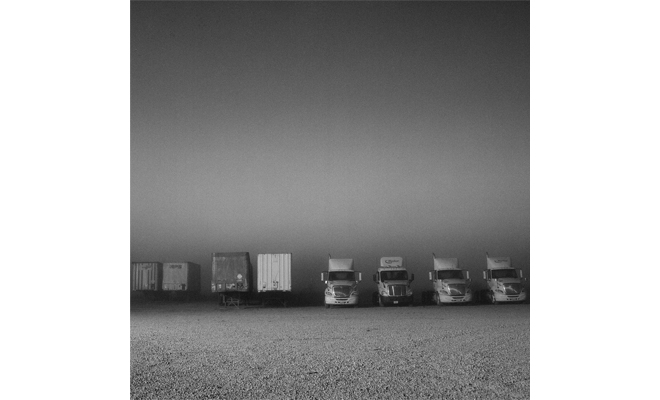Review: David Armentor at Cole Pratt Gallery

David Armentor, Mark Judice (left) and Jose Alberto Pacheco Gonzalez, ''Alberto'' (right), both 2012. Both encaustic coated photographs. Courtesy the artist and Cole Pratt Gallery, New Orleans.
From minimal landscapes of sugar cane fields to abstract compositions of mill machinery, David Armentor documents the many facets of south Louisiana’s sugar industry. Organized into chapters, what is most captivating about “The Sugar Mill Sessions” is Armentor’s approach to each chapter as distinct. Each relies on different photographic techniques, including various lenses, to transform a common subject into a more complex and subtle investigation of shifting agricultural conditions and histories.
Sunrise at the Cooling Ponds, Cajun Mill, 2012, is one of three large photographs on display that focuses on the sky. Part of Armentor’s newest study of what he describes as the culture of the industry in the chapter “After the Harvest,” these images actually picture the vast lands and sweeping horizons surrounding the fields and mills. Their soft colors contrast the black-and-white abstracted machines across the room, a reminder of how industrialization has transformed these areas. This sentiment is echoed by Trucks, Cajun Mill, 2012, a more recent addition to “The Harvest,” a chapter Armentor began around 2004. Four 18-wheelers and four shipping containers line a gravel parking lot, their heavy rectangular fronts mirroring each other across the work. The photograph’s simple geometries exemplify the modern, monumental structures that have not only displaced the gentle curves of ponds and trees throughout the state, but also the need for human labor in many industries.
In the row of eleven portraits that constitutes the “Planting Season” chapter, men stand alone or in small groups against landscapes that blur into the distance. Shot with a pre-Civil War-era lens, Armentor documents these field workers in the midst of a burgeoning sugar cane crop. The photograph’s sepia tones and the men's dutiful and honorable poses are reminiscent of the grandeur with which Civil War leaders were recorded. Adding to the ghostly quality of the fading portraits, Armentor has painted their surfaces with encaustic, creating a smoky overlay and seemingly sealing their contents in time.
If we consider Armentor’s earliest, modernist images as charting the industrial advances in sugar production, his field portraits highlight the persistence of tradition and its emerging narratives. Sugar is one industry where individual workers remain present in the fields, carrying out tasks such as walking behind trucks, row after row, to drop seeds during planting season. Within the series of portraits, Mark Judice, an eighth generation New Iberia Mill farmer whose family owns the mill, stands alongside Jose Alberto Pacheco Gonzalez, one of the many field workers lining the wall from Mexico. Here, what began as a study of familiarity more than eight years ago evolves into a deeper cultural analysis, as Armentor continues to unearth the fertile dichotomies of a longstanding Southern industry and how it shapes both lives and communities.

David Armentor, Trucks, Cajun Mill, 2012. Archival pigment print. Courtesy the artist and Cole Pratt Gallery, New Orleans.
Editor's Note
"The Sugar Mill Sessions" on view until August 10 at Cole Pratt Gallery (3800 Magazine Street) in New Orleans.



